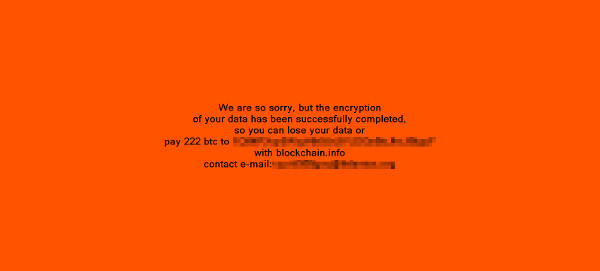RANSOM_KILLDISK.B
Trojan.Win32.KillDisk.fx (Kaspersky), Win32/KillDisk.NBK trojan (NOD32), Trojan.Disakil (Symantec)
Windows


Threat Type: Trojan
Destructiveness: No
Encrypted: Yes
In the wild: Yes
OVERVIEW
This Trojan arrives on a system as a file dropped by other malware or as a file downloaded unknowingly by users when visiting malicious sites.
TECHNICAL DETAILS
Arrival Details
This Trojan arrives on a system as a file dropped by other malware or as a file downloaded unknowingly by users when visiting malicious sites.
Installation
This Trojan terminates itself if it finds the following processes in the affected system's memory:
- avp.exe
- avpui.exe
- ekrn.exe
- egui.exe
- mfemmc.exe
- mfefire.exe
- mfevtps.exe
- pefservice.exe
- mcsvhost.exe
- msascui.exe
- msmpeng.exe
- mpcmdrun.exe
Autostart Technique
This Trojan registers itself as a system service to ensure its automatic execution at every system startup by adding the following registry entries:
HKEY_LOCAL_MACHINE\SYSTEM\CurrentControlSet\
Services\updcent
DisplayName = System update center
HKEY_LOCAL_MACHINE\SYSTEM\CurrentControlSet\
Services\updcent
ErrorControl = "1"
HKEY_LOCAL_MACHINE\SYSTEM\CurrentControlSet\
Services\updcent
ImagePath = "{malware path and filename} -opt=svc"
HKEY_LOCAL_MACHINE\SYSTEM\CurrentControlSet\
Services\updcent
ObjectName = "LocalSystem"
HKEY_LOCAL_MACHINE\SYSTEM\CurrentControlSet\
Services\updcent
Start= = "2"
HKEY_LOCAL_MACHINE\SYSTEM\CurrentControlSet\
Services\updcent
Type = "10"
HKEY_LOCAL_MACHINE\SYSTEM\CurrentControlSet\
Services\updcent\Enum
0 = "Root\LEGACY_UPDCENT\0000"
HKEY_LOCAL_MACHINE\SYSTEM\CurrentControlSet\
Services\updcent\Enum
Count = "1"
HKEY_LOCAL_MACHINE\SYSTEM\CurrentControlSet\
Services\updcent\Enum
NextInstance = "1"
It adds and runs the following services:
- updcent (System update center)
It registers as a system service to ensure its automatic execution at every system startup by adding the following registry keys:
HKEY_LOCAL_MACHINE\SYSTEM\CurrentControlSet\
Services\updcent
Other System Modifications
This Trojan adds the following registry keys:
HKEY_LOCAL_MACHINE\SOFTWARE\Microsoft\
UpdateCenter
It adds the following registry entries:
HKEY_LOCAL_MACHINE\SOFTWARE\Microsoft\
UpdateCenter
LastUpdate = {value}
HKEY_LOCAL_MACHINE\SOFTWARE\Microsoft\
UpdateCenter
FirstUpdate = {value}
HKEY_LOCAL_MACHINE\SOFTWARE\Microsoft\
UpdateCenter
NextUpdate = {value}
Other Details
This Trojan encrypts files with the following extensions:
- .3ds
- .7z
- .accdb
- .accdc
- .ai
- .asp
- .aspx
- .avhd
- .back
- .bak
- .bin
- .bkf
- .cer
- .cfg
- .conf
- .crl
- .crt
- .csr
- .csv
- .dat
- .db3
- .db4
- .dbc
- .dbf
- .dbx
- .djvu
- .doc
- .docx
- .dr
- .dwg
- .dxf
- .edb
- .eml
- .fdb
- .gdb
- .git
- .gz
- .hdd
- .ib
- .ibz
- .io
- .jar
- .jpeg
- .jpg
- .jrs
- .js
- .kdbx
- .key
- .max
- .mdb
- .mdbx
- .mdf
- .mkv
- .mlk
- .mp3
- .msi
- .my
- .myd
- .nsn
- .oda
- .ost
- .ovf
- .p7b
- .p7c
- .p7r
- .pd
- .pem
- .pfx
- .php
- .pio
- .piz
- .png
- .ppt
- .pptx
- .ps
- .ps1
- .pst
- .pvi
- .pvk
- .py
- .pyc
- .rar
- .rb
- .rtf
- .sdb
- .sdf
- .sh
- .sl3
- .spc
- .sql
- .sqlite
- .sqlite3
- .tar
- .tiff
- .vbk
- .vbm
- .vbox
- .vcb
- .vdi
- .vfd
- .vhd
- .vhdx
- .vmc
- .vmdk
- .vmem
- .vmfx
- .vmsd
- .vmx
- .vmxf
- .vsd
- .vsdx
- .vsv
- .wav
- .wdb
- .xls
- .xlsx
- .xvd
- .zip
It does the following:
- It accepts the following arguments:
- -set={value} → used to set time
- -est={value}
- -opt={param}
where {param} can be any of the following:- frc → encrypt files
- chk
- cnc
- pic → display image
- svc → run as service
- It may terminate any process except the following:
- smss.exe
- csrss.exe
- wininit.exe
- services.exe
- lsass.exe
- lsm.exe
- svchost.exe
- winlogon.exe
- explorer.exe
- dwm.exe
- wuauclt.exe
- spoolss.exe
- spoolsv.exe
- audiodg.exe
- taskhost.exe
- conhost.exe
- shutdown.exe
- Reboot the system
NOTES:
It may display the following image:

SOLUTION
Step 1
Before doing any scans, Windows XP, Windows Vista, and Windows 7 users must disable System Restore to allow full scanning of their computers.
Step 2
Note that not all files, folders, and registry keys and entries are installed on your computer during this malware's/spyware's/grayware's execution. This may be due to incomplete installation or other operating system conditions. If you do not find the same files/folders/registry information, please proceed to the next step.
Step 3
Restart in Safe Mode
Step 4
Disable this malware service
- updcent(System update center)
Step 5
Delete this registry key
Important: Editing the Windows Registry incorrectly can lead to irreversible system malfunction. Please do this step only if you know how or you can ask assistance from your system administrator. Else, check this Microsoft article first before modifying your computer's registry.
- In HKEY_LOCAL_MACHINE\SYSTEM\CurrentControlSet\Services
- updcent
- updcent
- In HKEY_LOCAL_MACHINE\SOFTWARE\Microsoft
- UpdateCenter
- UpdateCenter
Step 6
Restart in normal mode and scan your computer with your Trend Micro product for files detected as RANSOM_KILLDISK.B. If the detected files have already been cleaned, deleted, or quarantined by your Trend Micro product, no further step is required. You may opt to simply delete the quarantined files. Please check this Knowledge Base page for more information.
Step 7
Scan your computer with your Trend Micro product to delete files detected as RANSOM_KILLDISK.B. If the detected files have already been cleaned, deleted, or quarantined by your Trend Micro product, no further step is required. You may opt to simply delete the quarantined files. Please check this Knowledge Base page for more information.
Step 8
Restore encrypted files from backup.
Did this description help? Tell us how we did.

